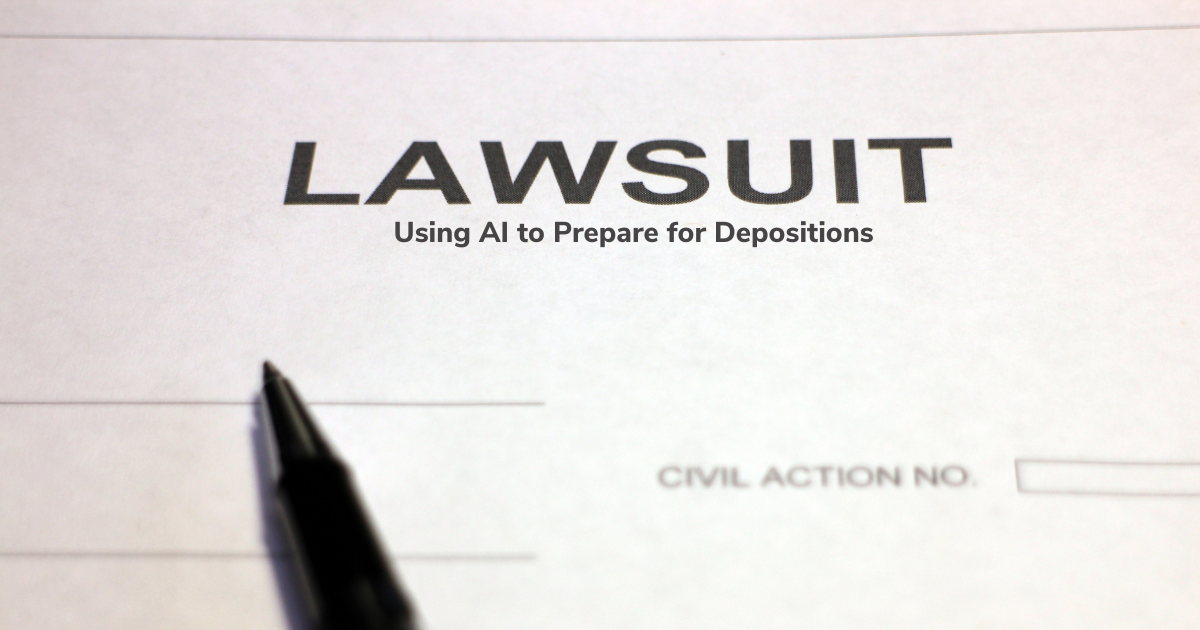Using AI to Prepare for Depositions
“If you don’t know where you are going, you might wind up someplace else.” – Yogi Berra
Artificial intelligence tools can help you get work done faster and better at every stage of a lawsuit – a topic I have been addressing in an ongoing series of posts. Today’s post looks at a few of the many ways to use AI when preparing to take a deposition.
Earlier posts in the series are:
- AI Across the Life of a Lawsuit
- Using AI to Prepare Complaints: Part 1, The Complaint
- Using AI to Prepare Complaints: Part 2, The AI
- Using AI to Prepare the Answer to a Complaint
Discovery
To prepare cases for trial, parties conduct discovery. This is a formal process, governed by the applicable federal or state rules of civil or criminal procedure.
During discovery, parties have formal tools they can use to obtain information. These tools include interrogatories, requests for production of documents, requests to admit, and depositions. Some of the information obtained through discovery ultimately will use at trail should the case get that far. Some of the information will be used before trial as team members pursue various objectives. These objectives can include, but are not limited to:
- To obtain yet more information,
- To support arguments made to the court,
- To help shape the case they intend to present at trial by defining the case, further strengthening strong points, and shoring up weak ones,
- To help identify the case they think others likely intend to present at trial, identifying strengths and weaknesses, and
- In support of other aspects of the case where needed, including potential mediation, arbitration, third-party actions, and so on.
Depositions
Depositions are one of the formal mechanisms designed to facilitate discovery. Basically, a deposition is a proceeding where an attorney asks questions of a witness. The witness is called a deponent.
Why Take Depositions
Depositions are taken for various reasons. Most depositions are taken for multiple reasons, not just one. The reasons include but need not be limited to:
- Discovering information about the case.
- Assessing the witness.
- Testing potential stories of the case.
- Obtaining information to use for motions or trial.
- Obtaining admissions from the witness.
- Preserving the witness’s testimony.
Types of Depositions
The three most common types of depositions are:
- Fact witness depositions. A fact witness is someone who has firsthand knowledge about facts that are potentially relevant to the lawsuit.
- Corporate representative depositions. FRCP Rule 30(b)(6) and comparable state rules allow a party to name an entity as a deponent. The named organization designates a person to testify on its behalf. That person testifies about information known or reasonably available to the organization.
- Expert witness depositions. FRCP Rule 26 and Rule 702 of the Federal Rules of Evidence provide for testimony from expert witnesses. An expert witness is someone with specialized knowledge or experience that could help a judge or jury.
The Mechanics of Depositions
Typically, depositions are help at a lawyer’s office, although especially in the wake of COVID-19 depositions may be held remotely. The deponent will be present. Also present will be the attorney (or attorneys) questioning the deponent and the attorney (or attorneys) representing the deponent. A court reporter will be there; the court reporter swears in the witness and records what is said at the deposition. If it is a videotaped deposition, a videographer will be there as well. Depending on the deposition also in attendance might be attorneys for other entities, clients or client representatives, other witnesses, or yet other categories of people.
At the deposition, the deponent is sworn in. The attorney taking the deposition asks questions of the deponent. The deponent generally is expected to answer those questions.
After a question is posed but before it is answered, the attorney defending the deposition might object to the question. In response, the attorney taking the deposition might rephrase the question. If not, the defending attorney will either instruct the witness not to answer or will tell the witness to go ahead and respond.
Rules Covering Depositions
The types of depositions that are available for attorneys to use, the number of depositions, the ways depositions are covered, and the uses to which depositions are put are covered by applicable rules.
Rule 30 of the Federal Rules of Civil Procedure defines the parameters of depositions by oral examination in the federal civil court system. Two other federal civil procedural rules govern other forms of depositions which I will not address today. Rule 27 covers depositions to perpetuate discovery. Rule 31 addresses depositions be written questions. Rule 15 of the Federal Rules of Criminal Procedure sets the scope of depositions in federal criminal matters.
State court systems have their own procedural rules for depositions, which generally are similar to the federal rules.
Most other countries “have an innate hostility towards the entire concept of pretrial exchange of documents and taking depositions,” according to Senior U.S. District Judge Michael Baylson.
Using AI to Help Prepare for and Take Depositions
There are, of course, many ways to prepare for taking or defending a deposition. As one who has taken and defended fact, corporate representative, and expert witness depositions, and as one who has been deposed as a corporate representative and an expert witness, I have seen many approaches. Here are some that seem to be more successful:
Remember That You Are Depleting a Scarce Resource
Depositions are a scarce commodity. In Federal court, by default each side only gets 10 depositions (Rule 30(a)(2)(A)) and each deposition is limited to one day of seven hours (Rule 30(d)(1)).
With only a limited number of depositions available and only a short period of time for each deposition, you want to use them wisely.
That starts with triage; you only get ten, so choose the deponents you think will deliver the greatest value. Having only 10 depositions means identifying dependencies: if you need testimony from Witness A to question Witness B, depose Witness A first. And a limit of 10 suggests that you might not want to schedule all 10 away, because then you will have no slots left for the key deponent you don’t yet know about.
Get to Know the Deponent
Before you walk into the deposition, you want to know your deponent as well as time and budget permit. Access to ESI gives you an ability to accomplish this which we rarely had when I first began handling depositions. Add in AI, and you more quickly and thoroughly learn about a witness than even before.
Develop Lines of Questioning
When I was in law school, our trail advocacy and legal aid instructors offered up a simple yet sophisticated framework for preparing for depositions that I have used to good end for 3½ decades. I don’t remember what they called this approach, but I think of it as the “T method”.
Start with a single sheet of paper (or a Word document, a PowerPoint file, or you medium of choice). Across the top, list the key topics you anticipate wanting to address. Under each key topic, list sub-topics. Keep this document handy as you research the deponent, modifying it as you go. Key it readily available when you depose the witness, so that you don’t forget to ask about the topics you care about.
Listen Carefully and Respond Accordingly
Every one of us who as taken a deposition has, at some point, failed to be sufficiently mindful during the deposition. Rather than focusing on the present moment and paying close attention to what the deponent is saying and doing, we let our attention stray. We also fail to pay close enough attention to what we and others in the room say and do.
What happens then? We miss potential critical opportunities. We think we asked the key question – but our wording was not quite right. We think we squeezed just the right answer out of the deponent – but the witness actually said something else. The deponent offered up a new and valuable piece of information, but in our concern about how to phrase the next question, we did not notice the import of what just was communicated.
Stay Flexible and Nimble
Deponents can surprise us, taking us down paths we had no idea existed, offering up lines of questioning we never anticipated. If – but only if – we prepared well and listen carefully, we can take advantage of these gems.
Using AI to Help Prepare for Depositions
You can get to know the deponent better with a wide array of AI capabilities. Here are just a few examples.
The Reveal baseball card and All Activity page
With Reveal’s baseball card and the related All Activity page, powered by AI-based entity extraction capabilities.
With the baseball card, you can see basic information about a deponent such as:
- Name: At the top of the card is the name by which that person most frequently appears in the data (in the example below, Vince J Kaminski).
- Email address: Immediately below is the person’s most frequently used email address (vkaminski@aol.com) as well as the total number of email addresses associated with that individual (55).
o Topics: Next are shown the three topics, or concepts, that appear most frequently in communications associated with that person (here, meeting, model, and energy).
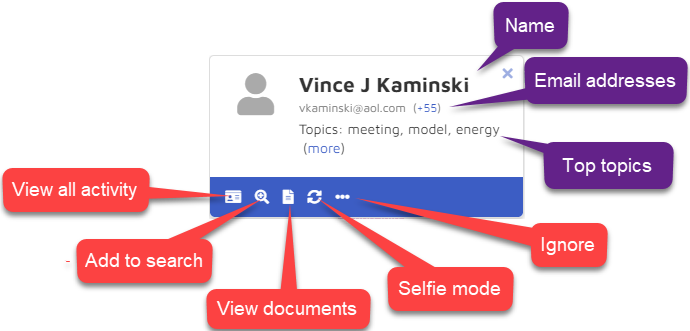
From the All Activities page, you can find:
- Email addresses the deponent used,
- Pseudonyms associated with the deponent,
- Job positions held by the deponent,
- Concepts contained in the deponent’s data such as email messages between the deponent and others,
- The identities of people with whom the deponent may have communicated, and
- The identities of people who discussed entities similar to those discussed by the deponent.
For more information, see Getting to Know You: Entity Extraction in Action.
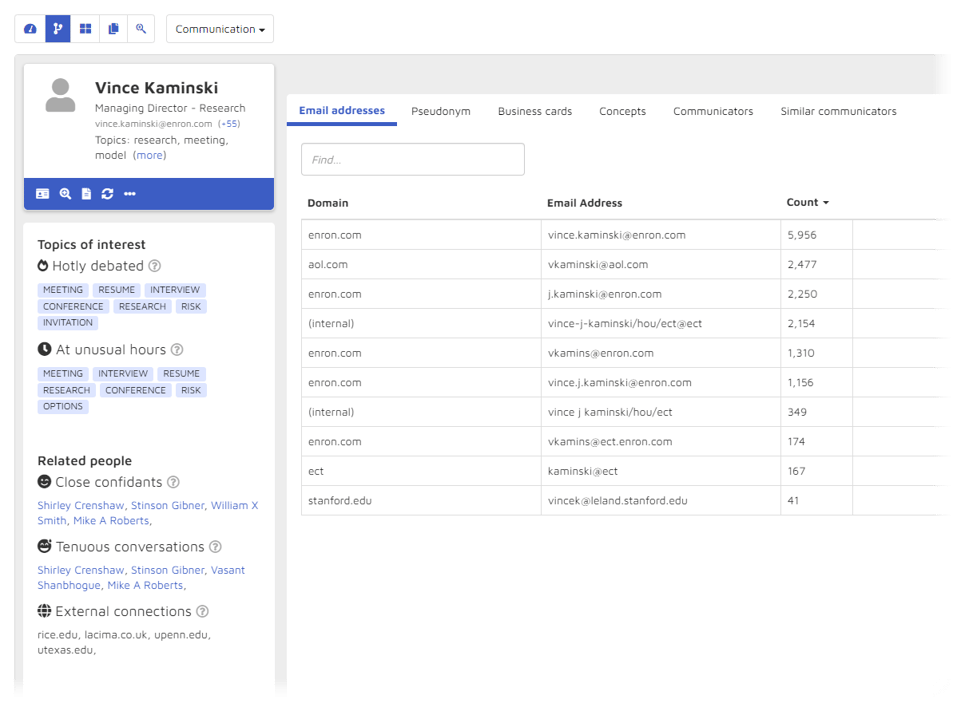
From the All Activity page, you call can see topics of interest and related people. Topics of interest are topics that are anomalous in one of two ways. Hotly debated topics of interest are topics from a person's documents with medium or high negative sentiment. At unusual hours topics of interest are topics from a person's documents that were sent after business hours or on weekends.
Related people are people who have out-of-the norm but meaningful connections with an individual. There are three categories under related people where communications fall outside the norm. Close confidants shows the top five people the individual in question communicated with most frequently. Tenuous communications displays the top four people this person communicated with where their communications show high pressure. External connections lists the top four external domains the person communicated with.
Communication Maps
For almost every deposition, we need to analyze communications. With tools such as communications maps, you can start to get a better understanding of, for example:
- How much a deponent communicated with others (or at least how many communications you currently have access to),
- When the deponent communicated with others,
- When there appear to be gaps in communications, and
- With whom the deponent communicated, how frequently, and when.
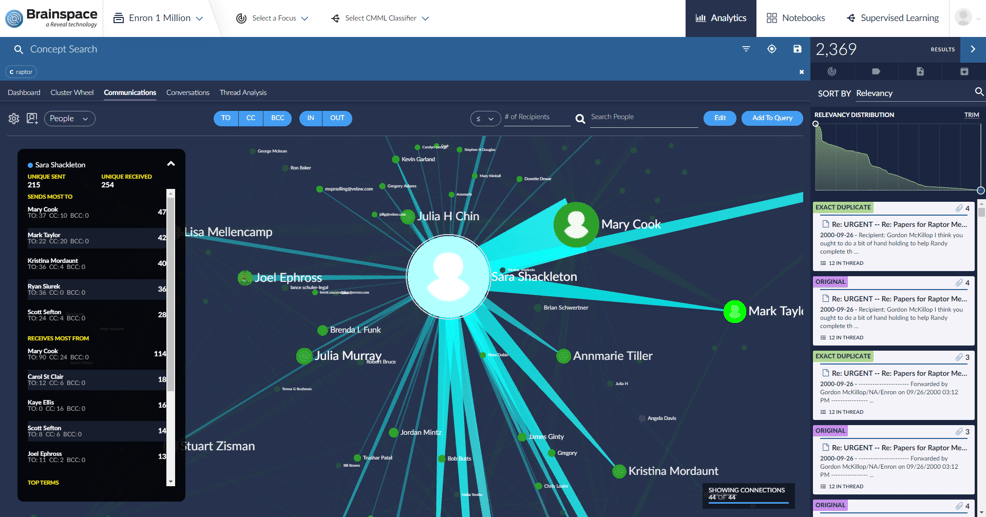
For a more detailed discussion of communications maps, go to Visualize: Analyzing Connections Between Communications.
AI Models
If you think you know what topics you want to explore with a deponent, AI models can jump-start the process of finding useful content.
Generally, an AI model is a software program that has been trained on a set of data to perform specific tasks like recognizing certain patterns. Artificial intelligence models use decision-making algorithms to learn from the training and data and apply that learning to achieve specific pre-defined objectives. For more about AI models, see What Is An AI Model?
When you run an AI model designed for a specific topic, the system finds and prioritizes content that
AI models can be layered together, as discussed in Layering Legal AI Models for Faster Insights. If you are preparing to take a deposition in a sexual harassment matter, for example, you might want to select four models from Reveal's AI Model Library related to harassment: Comments on Appearance, Employment & Career Advancement, Sexually Explicit Comments, and Work Events. You then would run the four models against your data. The platform scores the results.
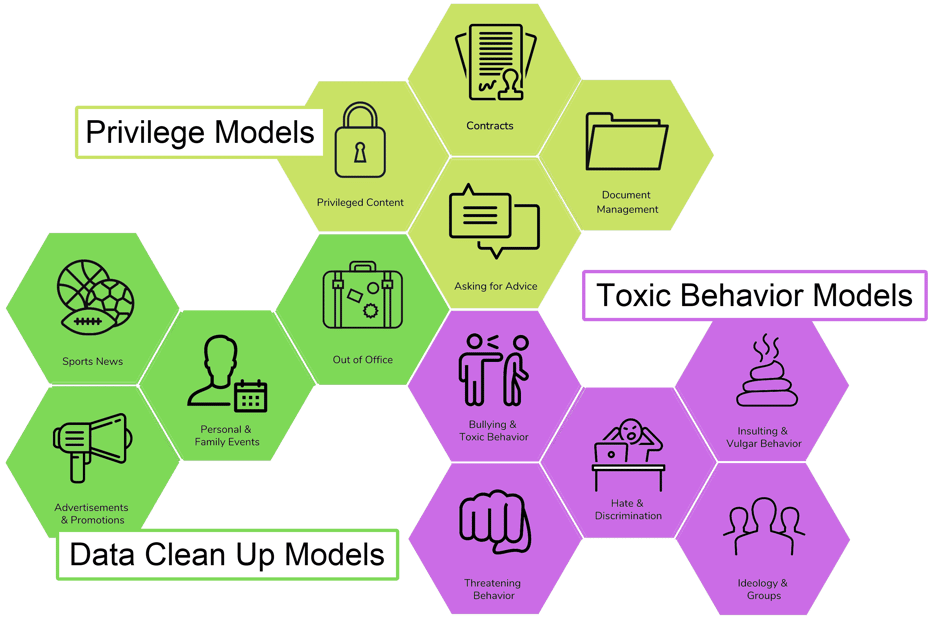
Concept Searching
Concept searching puts you at the driver’s wheel. With the right AI tools, you can search for concepts and then use tools such as cluster wheels to find high-level concepts quickly, drill in for greater details, and ultimately get to potentially key messages and other content, as discussed in Using AI to Prepare the Answer to a Complaint.
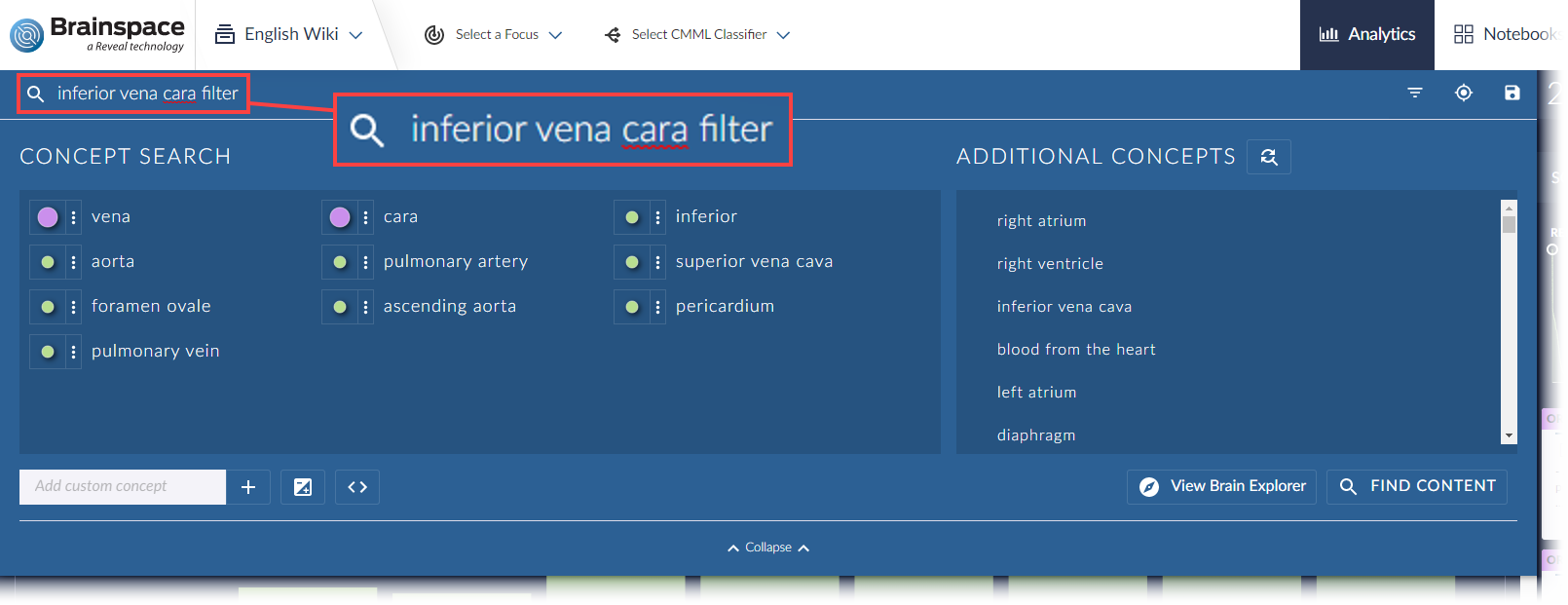
Data Visualization
Data visualization can help you literally see your data better. In Brainspace, you can get go from concept searching to data visualization, if that suits you needs, or you can go directly to visualization.
A prominent example of data visualization is the Cluster Wheel, the most widely used visual analytics feature in Reveal's Brainspace technology. With it, you can quickly and easily find the content that really matters. The Cluster Wheel is especially powerful when you are new to your data, not yet sure what you are looking for, and need tools that help guide you to the documents and communications that can make or break your matter.
Reveal's Brainspace technology does the initial arranging and classifying of data for you. It automatically organizes all your unstructured data into eight core clusters, plus a cluster for excluded items, all presented in a central ring with concentric levels of cluster wedges. Being able to dig into the concentric circles means you can chase down a thought or line of inquiry, find a cluster with potentially interesting documents, and look at them to see whether they tend to support your hypothesis, tend to refute it, or suggest a different approach.
For more information how to use the cluster wheel, see 11 Reasons Lawyers Love Reveal's Brainspace Cluster Wheel.
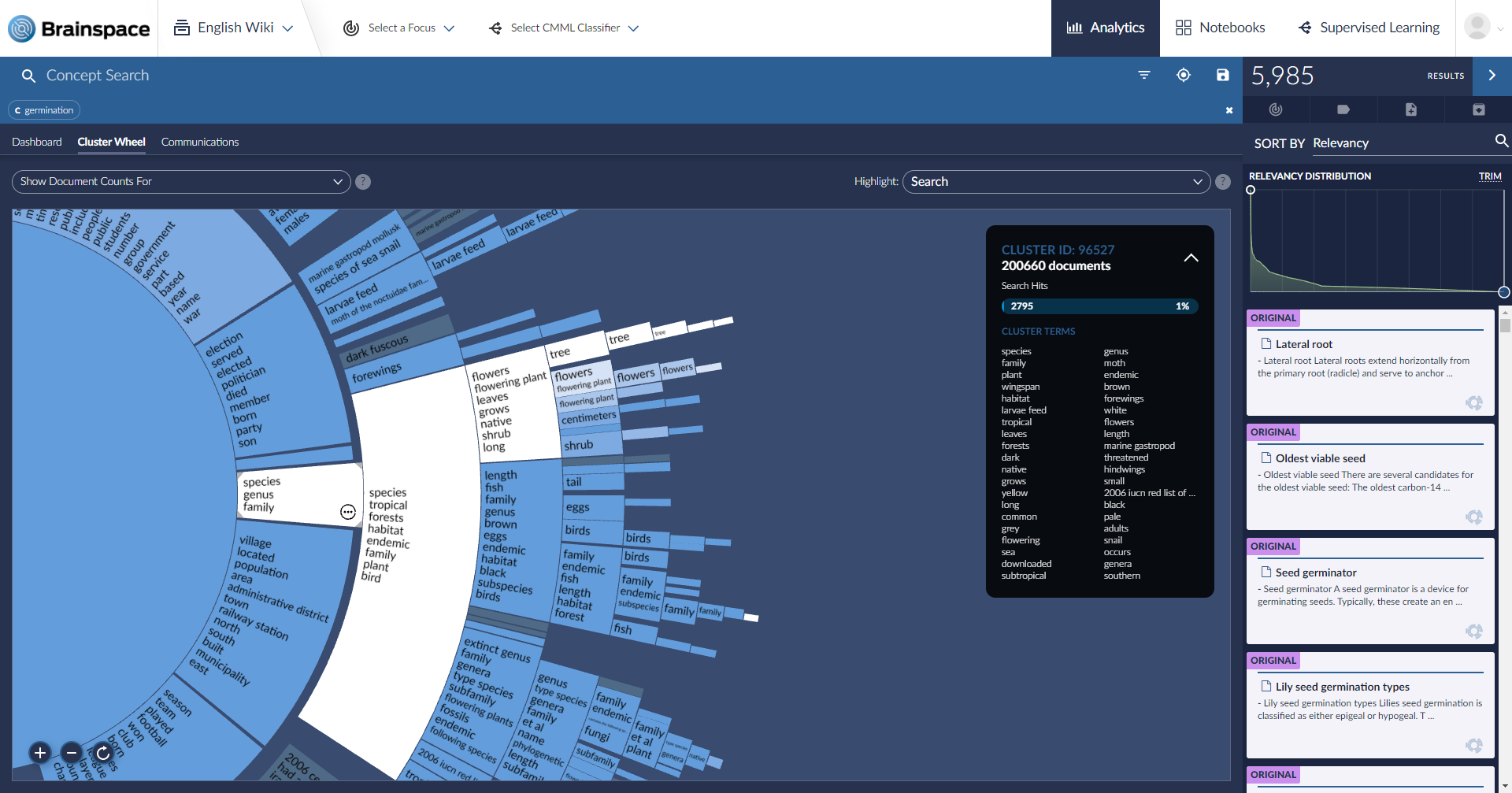
Sentiment Analysis
Our written communications can be heavily larded with “sentiment”. In common parlance, sentiment is “the emotional significance of a passage or expression as distinguished from its verbal context“. At Reveal, we characterize sentiment as the tone of the language used in a communication such an email message.
Reveal AI uses unsupervised machine learning to look for language expressing sentiment. Reveal AI looks for seven types of sentiments:
- Intent: Looking at someone’s intention or purpose. “I will do this.”
- Opportunity: Looking for circumstances making it possible for someone to do something. “I can do this.”
- Pressure: Looking for attempts to persuade, influence, intimidate. “You must do this.”
- Rationalization: Looking for attempts to explain or justify. “It’s okay to this because….”
- Sentiment Alternation: Looking for fluctuations in how people speak, detecting discomfort and tone changes, mainly to detect dishonesty.
- Positivity: Looking for content that tends to the positive and optimistic.
- Negativity: Looking for content where people discuss negative things, which can lead to discovering conversations about problems.
Using sentiment analysis, you can get search for emotionally charged communications involving – or about – the deponent. These capabilities might be useful, for example, when there are allegations of harassment, abuse, or any other situations where tempers run high.
For more on sentiment analysis, see Getting Sentimental: Using Emotional Signals in eDiscovery.
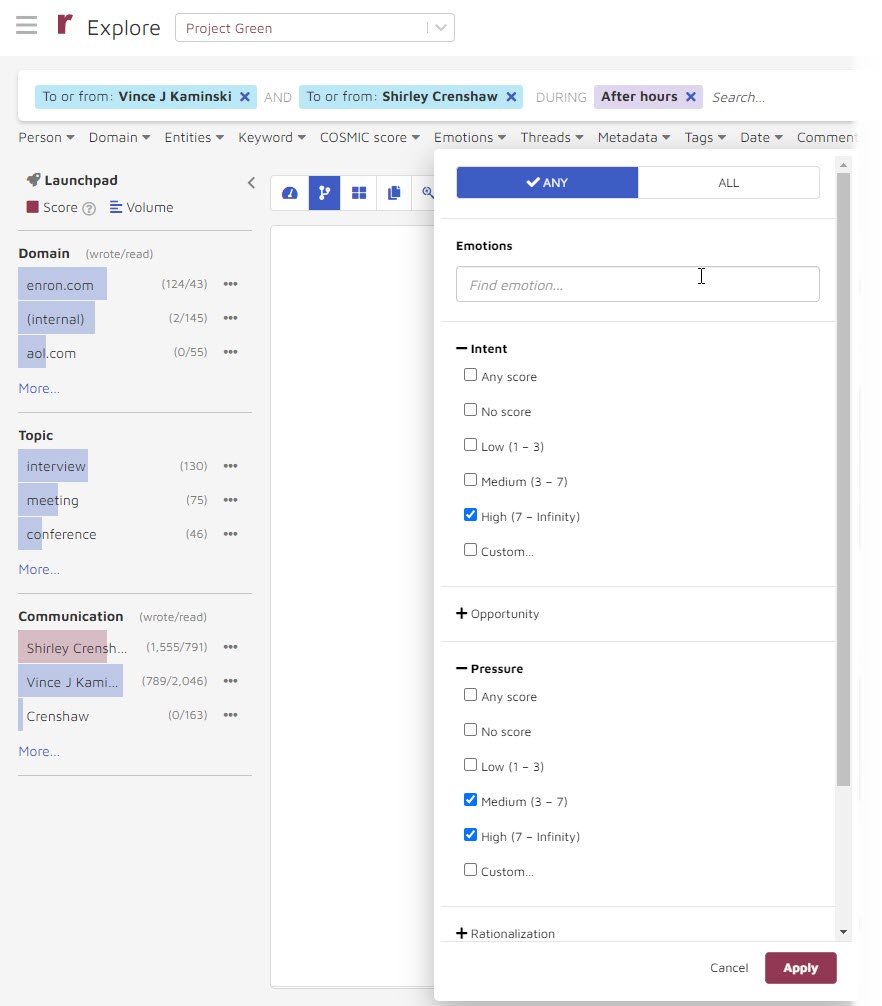
Image Labeling
A picture can be useful tool at a deposition, as illustrated by these examples:
- In a lawsuit alleging a serious lower-back soft-tissue injury, a photograph of the plaintiff winning a weight-lifting competition brought the case to a rapid close. In a similar case, a private investigator snapped a shot of the plaintiff hefting a heavy package delivered to his front door, prompting a quick settlement.
- Where a wood preservative allegedly failed to prevent wood windows and doors from rotting, many thousands of photos of rotting cut ends, window sills, and finger joints informed critical expert testimony.
- Where a motorcyclist brought product liability claims against the manufacturer of the bike he was riding when he was injured, a picture of cycle's gas tank showing that a different company had made the bike abruptly ended the matter - at least as far as our client was concerned.
Finding the right picture has challenging. With image recognition and labeling capabilities, however, the calculation has changed. For a discussion of AI image recognition and labeling and how it can add value, go to AI Image Recognition: The eDiscovery Feature You Didn't Know Existed.
To judge for yourself whether image labeling actually can work, check out Testing the Efficacy of Image Labeling.
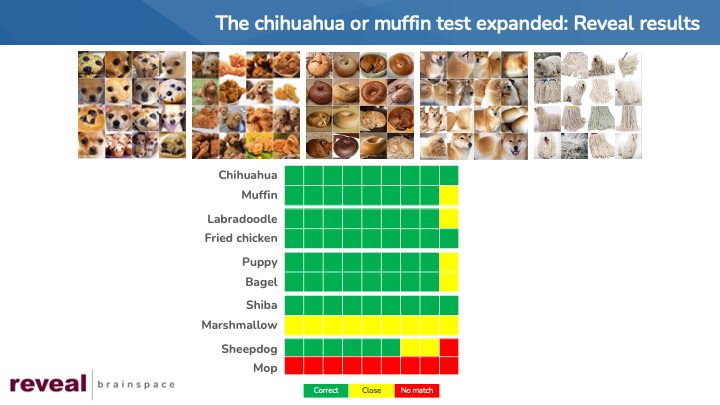
Try AI for Your Next Deposition
This post touched on only a few of the many ways you can use AI to help prepare for depositions.
With the right AI-driven platform, you can take and defend depositions better and faster, confident that you are serving your client well.
If your organization is interested in learning more about making more effective use of AI across the life of a lawsuit and find out how Reveal uses AI as an integral part of its AI-powered end-to-end legal document review platform, please contact us.

